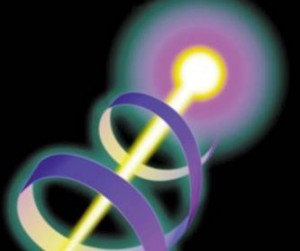The distribution of hydrogen in the Milky Way is something we’ve measured to a good degree of precision. Combined with computer models we can start to look at the dynamics of our galaxy. For example, back in 2009 a comparison was made between the observed distribution of atomic hydrogen in the Milky Way and possible effects of dark matter. Basically there are variations or ripples in the galactic hydrogen that don’t match up with the known distribution of visible matter, however computer simulations showed that these ripples could be caused by a localized clump of dark matter. That is, it seemed small satellite galaxy comprised mostly of dark matter is perturbing the gas and dust in our galaxy. While it was an interesting idea, proving that the ripples could be caused by dark matter isn’t the same as demonstrating that they are. But a new paper published in Astrophysical Journal Letters has strengthened the idea.
If such a dark matter “galaxy x” exists, then we should be able to find it. The problem is that a mostly dark matter dwarf galaxy wouldn’t be particularly bright, and what light it does emit could be dimmed by gas and dust in the way. But the simulations predicted a region where the cluster of dark matter should be, so the team began a search in that region. They used public data from the ESO Public survey VISTA Variables of the Via Lactea (VVV), gathered at infrared wavelengths. Near infrared wavelengths are useful because they are less affected by interstellar gas and dust. When they analyzed the data, the team found four Cepheid variable stars clustered in the same region of the sky near the galactic plane. Cepheid variables are useful because they vary in brightness in a specific way, and we can use that fact to determine their distance. When the team did this they found the stars were all about 294,000 light years away, give or take a bit. It would be very unusual to find four Cepheid variables so close together just by chance, so it is most likely the case that they are part of a previously unknown dwarf galaxy.
In the popular press this new work is generally being presented as the “discovery” of a dark matter galaxy, but that isn’t quite the case. This new work doesn’t conclusively prove a dark matter galaxy. What the work has done is taken an earlier prediction on the existence of a dark matter dwarf galaxy, and found a clustering of stars in the general location predicted by their model. This clustering of variable stars is consistent with their model. Once again it demonstrates the predictive power of dark matter models. It also demonstrates how useful public data can be, since data gathered for one project can be used in several others.
Paper: Sukanya Chakrabarti et al. Tidal imprints of a dark subhalo on the outskirts of the Milky Way. MNRAS 399 (1): L118-L122. (2009)
Paper: Sukanya Chakrabarti et al. Clustered Cepheid Variables 90 kiloparsec from the Galactic Center. Astrophysical Journal Letters 1502: 1358 (2015)











